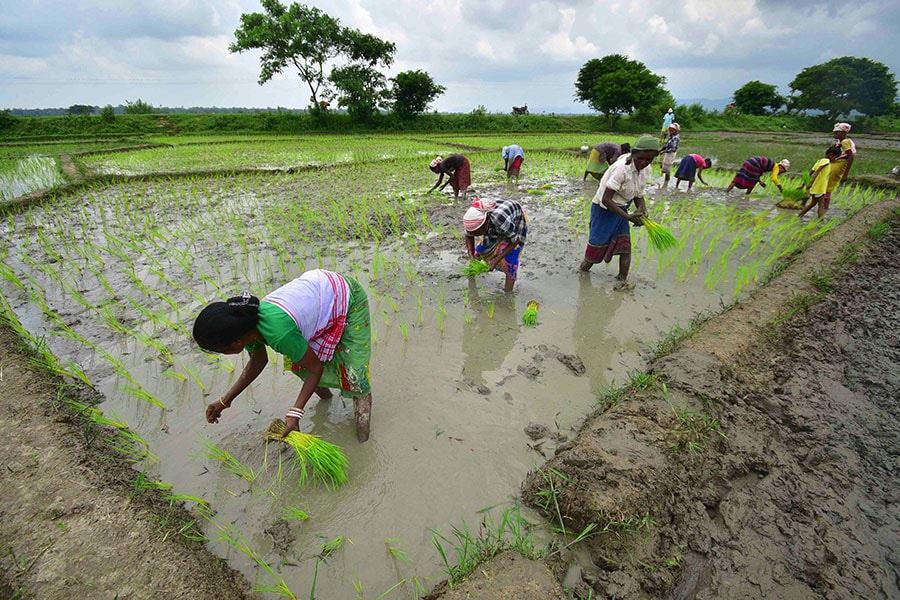Budget 2024 spotlights agriculture, overall rural recovery
The government has proposed allocation of Rs1.52 lakh crore for agriculture and allied sectors, with a provision of Rs2.66 lakh crore for rural development, including rural infrastructure. But is it enough to boost rural recovery?
 Farmers plant rice saplings at a paddy field in Nagaon District of Assam, India on July 14, 2024. Image:
Anuwar Hazarika/NurPhoto via Getty Images
Farmers plant rice saplings at a paddy field in Nagaon District of Assam, India on July 14, 2024. Image:
Anuwar Hazarika/NurPhoto via Getty Images
Finance Minister Nirmala Sitharaman proposed for allocation of Rs1.52 lakh crore for agriculture and allied sectors in the Union Budget 2024. Overall, she has made a provision of Rs2.66 lakh crore for rural development, including rural infrastructure. While retaining their capex growth targets at 17.1 percent year-on-year (YoY), as already indicated in the Budget, the government announced an increase in social welfare spending largely directed towards youth, women, MSME and agriculture.
As rural economy accounts for less than half of India's gross value added (GVA) with around two-thirds of India's population living in rural areas, the government has put its focus on productivity and resilience in agriculture as one of the key themes of nine priorities of the Budget in pursuit of ‘Viksit Bharat’.
“Our government will undertake a comprehensive review of the agriculture research set-up to bring the focus on raising productivity and developing climate-resilient varieties. Funding will be provided in challenge mode, including to the private sector. Domain experts both from the government and outside will oversee the conduct of such research,” said Sitharaman.
The Budget has proposed to release new 109 high-yielding and climate-resilient varieties of 32 field and horticulture crops for cultivation by farmers. In the next two years, one crore farmers across the country will be initiated into natural farming supported by certification and branding. Implementation will be through scientific institutions and willing gram panchayats. Ten thousand need-based bio-input resource centres will be established.
For achieving self-sufficiency in pulses and oilseeds, the government will strengthen their production, storage and marketing. As announced in the Interim Budget, a strategy is being put in place to achieve ‘atmanirbharta’ for oil seeds such as mustard, groundnut, sesame, soybean, and sunflower’, Sitharaman added.
Also read: What Budget 2024-25 says about India's energy security and transition roadmap
Large scale clusters for vegetable production will be developed closer to major consumption centres. The government will promote farmer-producer organisations, cooperatives and startups for vegetable supply chains, including for collection, storage and marketing.
According to Saugata Gupta, MD & CEO, Marico, the outlay of Rs2.66 lakh crore for rural development, and Rs1.52 lakh crore for agriculture and allied sectors will help in stabilising rural economies and ensuring farmers have access to essential resources. “The Budget allocated substantial funds towards infrastructure development which will enhance supply chain efficiency, facilitating wider distribution networks. Emphasis on digital infrastructure and connectivity enhancements are the other key positives,” he says.
The government, in partnership with the states, will facilitate the implementation of the Digital Public Infrastructure (DPI) in agriculture for coverage of farmers and their lands in three years. During this year, digital crop survey for Kharif using the DPI will be taken up in 400 districts. The details of six crore farmers and their lands will be brought into the farmer and land registries. Further, the issuance of Jan Samarth-based Kisan Credit Cards will be enabled in five states.Also read: Budget 2024: Govt seeks to boost job-creation through incentive schemes
“Our government will bring out a National Cooperation Policy for systematic, orderly and all-round development of the cooperative sector. Fast-tracking growth of rural economy and generation of employment opportunities on a large scale will be the policy goal,” said Sitharaman.
However, Tanvee Gupta Jain, economist, UBS, feels that while there were announcements on agriculture, rural and youth employment, the overall allocations appear small and are unlikely to move the needle immediately.
The government’s measures to push rural growth and higher spending are the need of the hour, as severe weather conditions have impacted farm income while food price inflation has stayed elevated for a longer period of time. Disruptions caused by heat waves and sporadic rains have led to a spike in prices of essential perishable food items like vegetables, pulses and spices. Gradual decline in inflation and a revival in the rural segment are critical for the new government—for both political stability and economic growth.Also read: Budget 2024: Internships for 1 crore youth at India's top companies
Rural spending (including the Ministry of Agriculture and Farmers' Welfare, department of fertilisers, department of drinking water and sanitation, Ministry of Panchayati Raj and Ministry of Rural development) grew faster than the total spending during UPA-I and the previous two regimes of the BJP-led government; it was almost stagnant during UPA-II.
Social sector push
The government says it will facilitate higher participation of women in the workforce by setting up working women’s hostels in collaboration with industry, and establishing creches. In addition, the partnership will seek to organise women-specific skilling programmes, and promotion of market access for women self-help group (SHG) enterprises.The finance minister reiterated need to focus on four major castes, namely ‘Garib’ (poor), ‘Mahilayen’ (women), ‘Yuva’ (youth) and ‘Annadata’ (farmer). For Annadata, the government had already announced higher minimum support prices (MSP) a month ago for all major crops, delivering on the promise of at least a 50 percent margin over costs. The Pradhan Mantri Garib Kalyan Anna Yojana was extended for five years, benefitting more than 80 crore people.
For promoting women-led development, the Budget carries an allocation of more than Rs3 lakh crore for schemes benefitting women and girls. This signals the government’s commitment for enhancing women’s role in economic development.

















